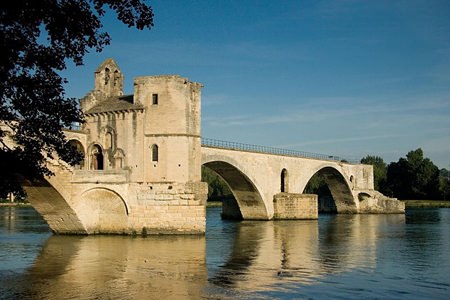You probably remember that old song called Sur le Pont d’Avignon (“On the Bridge of Avignon”) upon which, so the song tells us, everyone danced. The Bridge of Avignon (more correctly known as Pont Saint-Bénézet) crosses the River Rhône and was built during the twelfth century but later destroyed during a local skirmish. Eventually it was rebuilt with twenty-two stone arches but they tended to collapse from time to time when the turbulent Rhône flooded. Why people would feel compelled to dance on such an unstable structure remains a mystery and seems ever so slightly foolhardy. The bridge proved to be hopelessly expensive to maintain and after various attempts at re-building it, the thing was finally abandoned. The remaining arches, which date from the fourteenth century are all that’s left.
The Rhône River is one of the great waterways of Europe, rising high in the Swiss Alps. It’s been a lifeline for Western Civilization since Greek and Roman times and was the main trade route from the Mediterranean Sea to the heart of ancient Gaul. At just over five hundred miles in length, it’s also one of Europe’s longest rivers and the only important one that flows into the Mediterranean. The wine region known as the Côtes du Rhône (it means the “slopes” or “hills” of the Rhône) stretches over a hundred and fifty miles along the riverbank and far into the surrounding countryside, from Vienne in the north to Avignon in the south.
 The remains of Pont Saint-Bénézet and the Rhône River. (Photo: Charles Greenhough)
The remains of Pont Saint-Bénézet and the Rhône River. (Photo: Charles Greenhough)
Wines have been made in this region before Roman times, and those from the right bank were the favourites of kings and the papal community of Avignon. Nearly all the wines of the Côtes du Rhône are red, although a few white and rosé wines are produced. Only a few decades ago, Rhône wines were considered rustic plonk and uncouth country cousins of the elegant wines of Bordeaux and Burgundy. But things have changed dramatically, even though the wines still vary enormously in quality.
The region is divided into the Northern Rhône and the Southern Rhône which are actually quite separate regions about an hour’s drive apart. The wines are completely different due to climatic conditions, the position of the vineyards in relation to the river, the nature of the soil and the grapes that are used. Syrah is the only red grape of the north, while Grenache, Mouvedre and a dozen others are used in the south. Grenache is one of the most important and has long been used as a blending grape. Jancis Robinson writes that “In this part of the world, the blend of Grenache, Syrah and Mourvèdre is regarded as a kind of Holy Trinity.”
Most of the Côtes du Rhône (coat-duh-ROHN) wines you’ll find in Thailand are from the Southern Rhône. Seventy percent is produced by co-operatives which together sell hundreds of different brand names. Some of these brand names are even contrived to sound like private estates. Cunning fellows, those French.
Bonpas Côtes du Rhône AOC 2010 (red), France (Bt. 805 @ Villa)
Côtes du Rhône bottles look similar to Burgundy bottles, but they feel heavier and they’re invariably embossed with a coat of arms below the neck. Amazingly, Bonpas (the name comes from “Bon Passage”) has been in the wine trade since 1318; a total of almost seven centuries. The company is based near Avignon and one can’t help wondering what their wines were like in the very early days. This one is a very dark ruby red, and if you swirl it around in the glass for a few seconds you’ll see those syrupy “legs” appear, usually a sign of a high-alcohol wine. This one comes at 14% alcohol content and you can sense it on the “hot” aroma. I found that it caused the hairs inside my nose to tingle, which strangely enough, is rather a pleasant sensation. (I really think you should try to get out a bit more – Ed.)
There’s an enticing warm and sweet earthy aroma of herbs and spices with hints of plum and blueberry. The lively taste might come as a surprise because it has a bright tang of acidity that hits the tongue like a shooting star. There are flavours of plum, red fruit and spices but the wine is absolutely bone dry and an attractive touch of lightness. Côtes du Rhône wines often have a kind of primal quality and there’s a touch of the wild one here. The zesty tang would make it an excellent food partner and it’s the classic accompaniment to roast lamb. It would work well with most meat dishes and cheeses such as Bleu d’Auvergne, Reblochon, Camembert, Cantal and Comté which is one of the most popular cheeses in France, produced in the rich mountain pastures of the Jura.
Bouchard Aîné & Fils Côtes du Rhône AOC 2012 (red), France (Bt. 749 @ Villa)
If you want something a bit cheaper, you can’t go wrong with wines from Bouchard Aîné & Fils, founded in 1750 in Beaune, the historical heart of Burgundy. This wine is a lovely bright ruby-red and a slightly reserved aroma, so it takes a few minutes for the black fruit, dry spices and herbs to come through. There are typical Southern Rhône hints of earthy, country smells too.
The mouth-feel is soft with red fruit and it’s as dry as they come. There’s a gorgeous smack of well-rounded earthy tannins that persists right through the long and satisfying finish. Although the wine is medium-bodied there’s a lovely touch of lightness. It would make an excellent food partner because Côtes du Rhône wines go well with every-day dishes and make a good partner for roasted red meat and game. I read somewhere that they go well with pizza.
This is my kind of wine and very French in style, which on reflection is hardly surprising. It rather puts me in the mood for a song, so a few verses of Sur le Pont might be a pleasant diversion. On second thoughts, perhaps not. The dogs have gone to sleep and if I were to wake them up, even with a tastefully performed French folksong, I would never hear the end of it.




